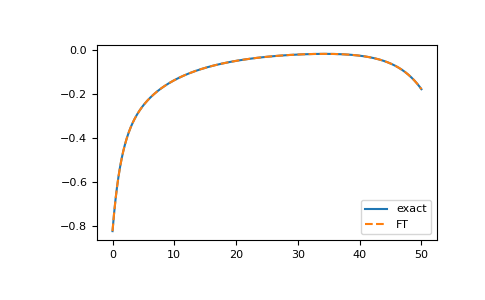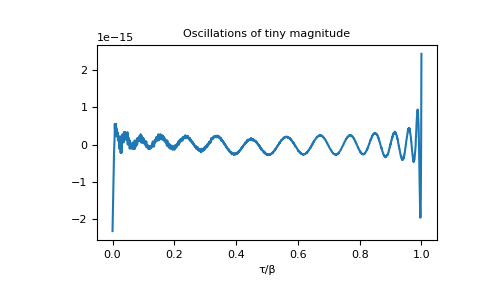gftool.fourier.izp2tau¶
-
gftool.fourier.izp2tau(izp, gf_izp, tau, beta, moments=(1.0))[source]¶ Fourier transform of the Hermitian Green’s function gf_izp to tau.
Fourier transformation of a fermionic Padé Green’s function to imaginary-time domain. We assume a Hermitian Green’s function gf_izp, i.e. \(G(-iω_n) = G^*(iω_n)\), which is the case for commutator Green’s functions \(G_{AB}(τ) = ⟨A(τ)B⟩\) with \(A = B^†\). The Fourier transform gf_tau is then real.
TODO: this function is not vectorized yet.
- Parameters
- izp, gf_izp(N_izp) float np.ndarray
Positive fermionic Padé frequencies \(iz_p\) and the Green’s function at specified frequencies.
- tau(N_tau) float np.ndarray
Imaginary times 0 <= tau <= beta at which the Fourier transform is evaluated.
- betafloat
The inverse temperature \(beta = 1/k_B T\).
- moments(m) float array_like, optional
High-frequency moments of gf_izp.
- Returns
- gf_tau(N_tau) float np.ndarray
The Fourier transform of gf_izp for imaginary times tau.
See also
iw2tauFourier transform from fermionic Matsubara frequencies.
_z2polegfFunction handling the fitting of gf_izp
Notes
The algorithm performs in fact an analytic continuation instead of a Fourier integral. It is however only evaluated on the imaginary axis, so far the algorithm was observed to be stable
Examples
>>> BETA = 50 >>> izp, __ = gt.pade_frequencies(50, beta=BETA) >>> tau = np.linspace(0, BETA, num=2049, endpoint=True)
>>> poles = 2*np.random.random(10) - 1 # partially filled >>> weights = np.random.random(10) >>> weights = weights/np.sum(weights) >>> gf_izp = gt.pole_gf_z(izp, poles=poles, weights=weights) >>> gf_ft = gt.fourier.izp2tau(izp, gf_izp, tau, beta=BETA) >>> gf_tau = gt.pole_gf_tau(tau, poles=poles, weights=weights, beta=BETA)
>>> import matplotlib.pyplot as plt >>> __ = plt.plot(tau, gf_tau, label='exact') >>> __ = plt.plot(tau, gf_ft, '--', label='FT') >>> __ = plt.legend() >>> plt.show()

>>> __ = plt.title('Oscillations of tiny magnitude') >>> __ = plt.plot(tau/BETA, gf_tau - gf_ft) >>> __ = plt.xlabel('τ/β') >>> plt.show()

Results of
izp2taucan be improved giving high-frequency moments.>>> mom = np.sum(weights[:, np.newaxis] * poles[:, np.newaxis]**range(4), axis=0) >>> for n in range(1, 4): ... gf = gt.fourier.izp2tau(izp, gf_izp, tau, beta=BETA, moments=mom[:n]) ... __ = plt.plot(tau, abs(gf_tau - gf), label=f'n_mom={n}') >>> __ = plt.legend() >>> plt.yscale('log') >>> plt.show()

The method is resistant against noise:
>>> magnitude = 2e-7 >>> noise = np.random.normal(scale=magnitude, size=gf_izp.size) >>> gf = gt.fourier.izp2tau(izp, gf_izp + noise, tau, beta=BETA, moments=(1,)) >>> __ = plt.plot(tau/BETA, abs(gf_tau - gf)) >>> __ = plt.axhline(magnitude, color='black') >>> plt.yscale('log') >>> plt.tight_layout() >>> plt.show()

>>> for n in range(1, 4): ... gf = gt.fourier.izp2tau(izp, gf_izp + noise, tau, beta=BETA, moments=mom[:n]) ... __ = plt.plot(tau/BETA, abs(gf_tau - gf), '--', label=f'n_mom={n}') >>> __ = plt.axhline(magnitude, color='black') >>> __ = plt.plot(tau/BETA, abs(gf_tau - gf_ft), label='clean') >>> __ = plt.legend() >>> plt.yscale('log') >>> plt.tight_layout() >>> plt.show()
